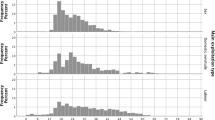Abstract
Human trafficking is a complex global and national crime problem harming victims physically, psychologically, and financially. The Trafficking Victims Protection Act of 2000 (TVPA), Pub. La 106–386, and subsequent reauthorizations, provide assistance and benefits to foreign born victims of labor or sexual human trafficking who are here in the United States. The strategies used to encourage victims to come forward were modeled on those used in the anti- domestic violence (DV) and child protection movements. These include initiatives alerting the public to domestic violence situations through awareness campaigns to increase tips as well as calls for service to police. Other public service initiatives urge victims themselves to self-identify by calling 1-800 numbers. While these techniques have shown success in reducing incidences of domestic violence and providing help to victims, their use to combat sex trafficking has not produced the same level of results. This note explores the challenges for immigrant women victims to self-identify as trafficking victims and urges that evidence-based research is needed to determine the efficacy of a national call center approach.
Similar content being viewed by others
Notes
Monthly call and email data tallies were reported to DHHS-ORR and other federal agencies involved with anti-trafficking programs. In 2008, DHHS-ORR and Lockheed Martin, the federal contractor for the project granted this author permission to examine the data.
The contract start date was early in June 2005. During 2006, the Rescue and Restore awareness campaign was suspended for contract re-procurement which may explain drops in call volume during some months. During 2007, DHHS authorized billboard PSA ads be placed in strategic cities to increase awareness beyond distribution of just printed and web-based materials which may have increased call volumes during the months that the ads were introduced. The final contract year ran from June to mid November.
References
Bales K (2009) The slave next door: human trafficking and slavery in America today. University of California Press, Berkeley
Berns N (2004) Framing the victim: domestic violence, media and social problems. W. de Gruyter, Berlin
Brennan D (2008) Competing classes of victimhood? foreign and domestic victims of trafficking in the United States. Sex Res Soc Policy 5(4):45–61
Bui HN (2004) In the adopted land: abused immigrant women and the criminal justice system. Praeger, Westport
Clawson H, Solomon A, Goldblatt LG (2007) “Treating the hidden wounds: Trauma treatment and mental health recovery for victims of human trafficking” (N.d.) Issue Brief prepared for the U.S. Department of Health and Human Services, Office of the Assistant Secretary for Planning and Evaluation http:///aspe.hhs.gov/hsp/07/HumanTrafficking or http://www.icfi.com/markets/social -programs/(accessed June 2008)
Dewey S (2008) Hollow bodies institutional responses to sex trafficking in Armenia, Bosnia and India. Kumarian Press, Sterling
Dutton MA, Orloff LE, Hass GA (2000) Characteristics of help-seeking behaviors, resources and service needs of battered immigrant latinas: legal and policy implications. Georgetown J Poverty Law Policy 7:245
Farrell A, McDevitt J, Fahy S (2008) Understanding and improving law enforcement responses to human trafficking: final report. U.S. Department of Justice, National Institute of Justice, Washington
Leone JM, Johnson MP, Cohan CL (2007) Victim help seeking: differences between intimate terrorism and situational couple violence. Fam Relat 56:427–439
Pinn VW, Chunko MT (1997) The diverse faces of violence: minority women and domestic abuse. Acad Med 72(1 Suppl):65–71
Volpp L (1995) Working with battered immigrant women: a handbook to make services available. Family Violence Prevention Fund, San Francisco
Weitzer R (2005) The growing moral panic over prostitution and sex trafficking. Criminologist 30(5):1–5
Zhang S (2007) Smuggling and trafficking in human beings: all roads lead to America. Praeger, Westport
Author information
Authors and Affiliations
Corresponding author
Rights and permissions
About this article
Cite this article
Lange, A. Research note: challenges of identifying female human trafficking victims using a national 1-800 call center. Trends Organ Crim 14, 47–55 (2011). https://doi.org/10.1007/s12117-010-9107-8
Published:
Issue Date:
DOI: https://doi.org/10.1007/s12117-010-9107-8




